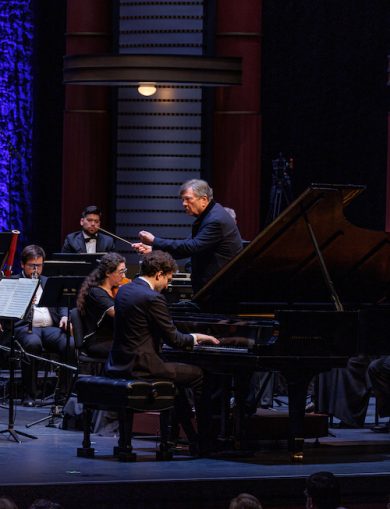With a last-minute pianist switch, the show goes on for Schwarz, Palm Beach Symphony

Rodolfo Leone performed Beethoven’s Piano Concerto No. 3 with Gerard Schwarz conducting the Palm Beach Symphony Monday night at the Kravis Center in West Palm Beach. Photo: IndieHouse Films
Like concerts around the world this week, the Palm Beach Symphony’s performance Monday night opened with the Ukrainian national anthem.
“We would like to honor the courageous people of Ukraine,” conductor Gerard Schwarz said, before musicians and audience at the Kravis Center stood for the stirring minor-key work.
The program opened with Beethoven’s Piano Concerto No. 3, with the young Italian-born pianist Rodolfo Leone serving as a last-minute replacement for Maria João Geissberger Pires, who bowed out for what the orchestra described as “personal reasons.”
Of the three most popular Beethoven piano concertos, the Third is the darkest and most formal. For the genial Fourth concerto and the exuberant Fifth, Beethoven went without the opening orchestral tutti that had been standard for classical concertos. But for the Third Concerto, the tutti appears in full formal dress, ending in a grim cadence. Austere and compact in texture, the opening tutti came off Monday with coiled energy, with particularly pointed and stylish playing in the elegant episode with which it concludes.
No one would have guessed the pianist was a last-minute stand-in. From the opening his playing with compelling and authoritative. He produced a silken tone in long lines of minor-key melody that seemed to look forward to the works of Chopin and Liszt, playing with just enough freedom to breathe life into the music while respecting its classical proportions.
Beethoven had urged piano manufacturers to produce more powerful instruments, and there’s no doubt he would have enjoyed the modern behemoth on the Kravis stage. Leone rarely drew on the instrument’s full resources, however, leaving some climactic moments feeling underpowered. But his playing had a fine sense of the dramatic. After the cadenza, in the crescendo that builds to the final chords, he held back on volume, then built it up suddenly, bringing the climax home with that much more ferocity.
In the Largo, the orchestra’s winds and muted strings produced glowing, soft-edged tones. A particularly striking episode came when Leone played soft arpeggios as the melody appears in the bassoon and flute.
For the concluding Rondo, he played with the precision of a jeweler, drilling into the notes in a tone so pointed that it came close to matching the oboe. As the music opened up, he played more expansively, drawing a full-bodied tone from the instrument as the mood brightened and the work raced to its triumphant conclusion.
Mahler’s Symphony No. 4 is considered the composer’s sunniest orchestral work—not that there’s much competition. But its joys are quiet and suffused with hints of darkness, and all this came through in the orchestra’s effective performance.
The work has a tone of its own, with transparent chamber-like textures that create a sonic world like the exposed girders of a building. Although violins occasionally lost precision in high passages, the orchestra for the most part rose to the occasion, with particularly fine playing throughout in the winds.
Schwarz led a relaxed account of the opening melodies, allowing the musicians to play in an expansive manner, with string melodies enlivened by a touch of schmaltz. The harsh, loud chord that changes everything came with particular force, leading to ghostly, unsettled playing before elements of the opening returned to restore tranquility.
The mood changes pile one on another in the second movement, from weird death-themed music to rustic folk song. Concertmaster Evija Osolins brought an apt touch of grotesquerie to her solos, playing on a down-tuned violin intended to represent death. Schwarz took his time in the Austrian ländler passages, stretching them out and allowing the orchestra to revel in the earthy music.
The slow movement came off as brisk and unsentimental. Where the music intensifies to a climactic two-note motif high in the violins, Schwarz kept the music moving, integrating these episodes into the surrounding music rather than making them leap from the stage.
In the finale, young soprano Emily Finke brought a rich tone, smooth phrasing and a bright innocence to the part of a child describing the joys of heaven. Incisive orchestral passages, topped by trumpets and edged with percussion, created an effective contrast to the vocal solo.
The Palm Beach Symphony’s next concert is 3 p.m. April 10 at the Kravis Center, with conductor Gerard Schwarz and violinist Midori in the Korngold Violin Concerto, Dvořák Symphony No. 8 and Schuman’s New England Triptych. palmbeachsymphony.org
Posted in Performances
Leave a Comment
Tue Mar 8, 2022
at 12:22 pm
No Comments